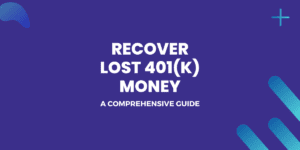In this article, we will walk you through the process of how to withdraw 401(k) before the retirement age of 59½. We will cover various withdrawal options, potential penalties, minimum age requirements, and important considerations to keep in mind.
Understanding these aspects will help you make informed decisions when accessing your hard-earned retirement savings.
Before delving into the withdrawal options, it’s crucial to highlight that 401(k) plans are designed to incentivize long-term savings for retirement.
Therefore, accessing your funds before retirement should generally be considered a last resort due to potential tax implications and penalties. However, life circumstances may necessitate accessing your 401(k) funds earlier than planned.
Steps to withdraw money from your 401(k)
To withdraw money from your 401(k)-retirement account, follow these steps:
Review Your 401(k) Plan
Find out about the specific rules and regulations of your 401(k) plan. Each plan will have a different withdrawal process.
Learn about eligibility for deposits. In most cases, you must meet age or certain conditions to withdraw funds.
Determine Your Withdrawal Reason
Identify the reason for withdrawing money from your 401(k). Common reasons include financial emergencies, major expenses, or retirement.
Assess the urgency of your need. It’s generally advisable to leave your funds in the account until retirement to maximize their growth potential.
Understand Tax Implications and Penalties
Recognize the tax implications of 401(k) withdrawals. Typically, withdrawals are considered taxable income, subject to ordinary income tax rates.
Be aware of potential penalties for early withdrawals if you’re below the age of 59½. Early withdrawals usually incur a 10% penalty, unless you qualify for an exception, such as financial hardship or disability.
Contact Your 401(k) Plan Administrator
Reach out to your 401(k) plan administrator to initiate the withdrawal process. They can provide the necessary forms and guidance.
Inquire about any specific documentation or requirements needed to process your withdrawal request.
Complete Withdrawal Forms
Obtain and carefully complete the withdrawal forms provided by your plan administrator. Ensure that you accurately provide all the required information, such as your personal details, withdrawal amount, and preferred payment method.
Review the forms thoroughly before submission to avoid errors or delays.
Select Your Withdrawal Method
Choose the method through which you want to receive your funds. Common options include direct deposit into your bank account or receiving a check.
Confirm the timeline for receiving your withdrawal and any associated fees or charges.
Monitor Tax Reporting
Keep track of the tax reporting related to your withdrawal. Your plan administrator should provide you with the necessary tax documentation, such as a Form 1099-R, which you’ll need when filing your income taxes.
Consider Professional Advice
If you’re uncertain about the withdrawal process or need assistance in assessing the potential impact on your finances, consider consulting a financial advisor or tax professional.
These professionals can provide personalized guidance based on your specific circumstances, help you navigate tax implications, and suggest strategies to optimize your financial situation.
The information provided here is a general overview and should not replace professional financial or tax advice. It’s essential to consult with experts who can evaluate your unique circumstances and provide tailored recommendations to meet your financial goals.
Withdrawal Options
When it comes to withdrawing money from your 401(k), several options are available. Here are some of the commonly used withdrawal methods:
Lump-Sum Distribution
A lump-sum distribution refers to withdrawing the entire balance of funds from a retirement account in a single payment. This option is available for various types of retirement plans, including 401(k)s, traditional IRAs, and pension plans. Here are some key points to understand about a lump-sum distribution:
Access to Funds: Opting for a lump-sum distribution provides immediate access to the entire amount saved in the retirement account. This can be useful if you need a large sum of money, such as paying off debt, covering medical expenses, or making a significant investment.
Tax Implications: It’s important to consider the tax implications of a lump-sum distribution. The withdrawn amount is generally treated as taxable income in the year of withdrawal. This means you will need to report it on your tax return and may be subject to income tax at your applicable tax rate. Depending on the amount withdrawn and your tax bracket, a significant portion of the distribution may go toward taxes.
Early Withdrawal Penalties: If you are under the age of 59½ at the time of the distribution, you may also be subject to an additional early withdrawal penalty imposed by the IRS. For most retirement plans, this penalty is 10% of the distributed amount. However, there are exceptions to this penalty, such as qualifying for certain hardships, becoming disabled, or using the funds for specific purposes like qualified education expenses.
Impact on Retirement Savings: Taking a lump-sum distribution means depleting your retirement savings in one go. This can have a long-term impact on your financial security during retirement. It’s important to carefully consider the implications, especially if you haven’t reached your desired retirement savings goal or if you anticipate needing the funds to support yourself in later years.
Rollover Options: Depending on your situation, you may have the option to roll over the distribution into another qualified retirement account, such as an Individual Retirement Account (IRA). This allows you to maintain the tax-advantaged status of the funds and potentially continue their growth over time.
Financial Guidance: When considering a lump-sum distribution, it’s advisable to consult with a financial advisor or tax professional. They can help you understand the tax consequences, evaluate the impact on your retirement plan, and provide personalized advice based on your specific financial goals and circumstances.
Remember, a lump-sum distribution is a significant financial decision that can have long-term consequences. It’s important to carefully assess your financial needs, tax obligations, and retirement plans before opting for this withdrawal option.
Periodic Payments
Periodic payments, also known as systematic withdrawals or regular distributions, are a method of accessing funds from a retirement account in regular installments over a specific period. This option allows you to receive a steady income stream from your retirement savings. Here’s what you need to know about periodic payments:
Scheduled Withdrawals: With periodic payments, you set up a schedule to receive regular withdrawals from your retirement account. These withdrawals can be monthly, quarterly, or annually, depending on your preference and the rules of your retirement plan.
Flexibility in Amounts: You have the flexibility to choose the amount of each withdrawal, as long as it meets the minimum requirements set by your retirement plan. You can determine a fixed amount for each payment or opt for a percentage-based withdrawal that adjusts based on the account balance.
Tax Considerations: The amount withdrawn through periodic payments is generally subject to income tax in the year it is received. The tax liability depends on your tax bracket and other sources of income. Consult with a tax professional to understand the specific tax implications based on your individual circumstances.
No Early Withdrawal Penalty: If you start periodic payments after reaching the age of 59½, you generally avoid the early withdrawal penalty of 10% imposed on early distributions. This allows you to access your retirement savings without incurring additional penalties.
Retirement Account Balance: With periodic payments, you don’t need to withdraw the entire account balance at once, unlike a lump-sum distribution. Instead, you can leave a portion of your retirement savings invested, potentially allowing it to continue growing and providing income for a longer period.
Planning for Long-Term Needs: Periodic payments can help you plan for your long-term financial needs in retirement. By receiving regular income, you can budget and manage your expenses more effectively, ensuring a steady cash flow to support your lifestyle.
Professional Advice: It’s important to consult with a financial advisor or retirement planner before setting up periodic payments. They can help you assess your retirement goals, determine the appropriate withdrawal amount, and design a payment schedule that aligns with your financial needs.
Periodic payments from a retirement account provide a regular income stream but require careful planning and consideration. Assess your financial situation, consult with professionals, and make informed decisions to ensure that your retirement savings last and support your desired lifestyle throughout your retirement years.
Annuity Option
The annuity option is a method of receiving retirement income by converting a portion or the entire balance of your retirement savings into an annuity. An annuity is a contract between an individual and an insurance company, providing a guaranteed income stream for a specified period or for life. Here’s what you need to know about the annuity option:
Definition: An annuity is a financial product designed to provide regular payments over a predetermined period or for the rest of your life. It serves as a way to convert a lump sum of retirement savings into a steady income stream.
Types of Annuities:
There are different types of annuities, including:
a. Immediate Annuities: With an immediate annuity, you make a lump-sum payment to an insurance company and start receiving regular income payments immediately.
b. Deferred Annuities: Deferred annuities allow you to invest a lump sum with an insurance company, and the payments begin at a later date. The investment grows tax-deferred until the income payments commence.
c. Fixed Annuities: Fixed annuities provide a guaranteed income stream by offering a fixed interest rate over the contract term. The payments remain the same throughout the chosen period.
d. Variable Annuities: Variable annuities allow you to invest in a selection of underlying investment options such as mutual funds. The income payments fluctuate based on the performance of the chosen investments.
e. Lifetime Annuities: Lifetime annuities provide income payments for as long as you live, ensuring you have a steady source of income throughout retirement.
Income Guarantees: Annuities offer income guarantees, meaning the insurance company promises to make regular payments for a specified period or for life. This can provide financial security, especially in retirement when a consistent income stream is crucial.
Tax Treatment: Annuity payments are generally subject to income tax. However, if you use funds from a qualified retirement account to purchase the annuity, such as a 401(k) or IRA, a portion of the payments may be considered tax-free return of principal.
Flexibility and Options: Annuities offer various options that can be tailored to your needs. These include joint and survivor annuities, which provide income for both you and your spouse, and inflation-adjusted annuities, which account for inflation over time.
Considerations: Before choosing the annuity option, carefully evaluate your retirement goals, financial situation, and risk tolerance. Consider factors such as fees associated with annuities, liquidity needs, and the potential impact on your estate planning.
Professional Guidance: Given the complexity of annuities and their long-term implications, it’s advisable to consult with a financial advisor or insurance specialist. They can help you understand the intricacies of annuities, assess your individual needs, and guide you towards the most suitable annuity product for your retirement goals.
Remember, the annuity option can provide a reliable income stream during retirement. However, it’s essential to thoroughly research and understand the terms, features, and potential risks associated with annuities before making any decisions. Seek professional advice to ensure that the annuity option aligns with your long-term financial objectives and retirement needs.
Hardship withdrawal
A hardship withdrawal is a provision that allows you to withdraw funds from your 401(k) account in cases of immediate and substantial financial need. This option is designed to help individuals address critical expenses during challenging times.
However, it’s important to note that not all 401(k) plans offer hardship withdrawals, and if available, there are specific rules and eligibility criteria that must be met. Here’s what you need to know about hardship withdrawals from your 401(k):
Eligibility and Qualifying Expenses: To qualify for a hardship withdrawal, you must demonstrate that you have an immediate and heavy financial need that cannot be met through other means. The Internal Revenue Service (IRS) defines certain expenses as qualifying hardships, such as:
a. Medical expenses for you, your spouse, or dependents.
b. Costs related to the purchase of your primary residence.
c. Tuition and educational fees for the next 12 months.
d. Payments necessary to prevent eviction or foreclosure.
e. Burial or funeral expenses for a deceased parent, spouse, or dependents.
Documentation and Proof: When requesting a hardship withdrawal, you will likely need to provide documentation or evidence of the financial need. This may include medical bills, tuition invoices, eviction notices, or other relevant supporting documents. Check with your plan administrator to understand the specific requirements and documentation needed.
Tax Consequences: Hardship withdrawals are generally subject to income tax. The amount withdrawn is considered taxable income and must be reported on your tax return for the year in which the withdrawal occurs. It’s important to factor in the potential tax liability and plan accordingly to avoid any unexpected tax obligations.
Penalties: In addition to income tax, if you are under the age of 59½, you may also be subject to an early withdrawal penalty of 10% imposed by the IRS. However, for hardship withdrawals, the penalty is waived. It’s essential to note that while the penalty may be waived, income tax will still apply unless an exception applies.
Withdrawal Limits: Hardship withdrawals are typically limited to the amount necessary to cover the immediate financial need. You cannot withdraw more than what is required to address the hardship. Additionally, the funds you withdraw cannot include any earnings on your contributions.
Impact on Retirement Savings: Withdrawing funds from your 401(k) through a hardship withdrawal reduces your retirement savings and may have a long-term impact on your financial security during retirement. It’s important to carefully consider the potential consequences and explore other alternatives before resorting to a hardship withdrawal.
Repayment Requirements: Unlike a 401(k) loan, hardship withdrawals generally do not require repayment. However, it’s important to note that depending on your plan’s rules, you may be restricted from making new contributions to your 401(k) for a specified period after taking a hardship withdrawal.
Roll-Over to an Individual Retirement Account (IRA)
Rather than withdrawing funds directly, you can roll over your 401(k) balance into an IRA.
This option allows you to maintain the tax-deferred status of your retirement savings while gaining more control over investment options.
IRAs offer a wide range of investment choices and flexibility in managing your funds.
You can then make withdrawals from the IRA according to your specific needs while considering the tax implications of each withdrawal.
It’s important to note that the best withdrawal option for you depends on your individual circumstances, financial goals, and retirement plans. Consider factors such as your age, income needs, tax situation, and long-term financial security when selecting the most suitable option. It is advisable to consult with a financial advisor or tax professional who can provide personalized guidance based on your specific situation and help you make informed decisions regarding your 401(k) withdrawal.
Minimum age for penalty-free withdrawals
The minimum age for penalty-free withdrawals from a 401(k)-retirement account is typically 59½ years. This means that if you withdraw funds from your 401(k) after reaching this age, you will not be subject to the early withdrawal penalty imposed by the IRS, which is typically 10% of the withdrawn amount.
Reaching the age of 59½ is a significant milestone for retirement accounts, as it marks the point at which individuals can access their 401(k) funds without incurring additional penalties.
At this age, you have the flexibility to withdraw funds for any purpose, whether it’s to cover living expenses, travel, or pursue other financial goals.
It’s important to note that although you can make penalty-free withdrawals after 59½, the withdrawals will still be subject to ordinary income tax.
The withdrawn amount will be treated as taxable income in the year of withdrawal, potentially affecting your overall tax liability.
Exceptions to the minimum age requirement for penalty-free withdrawals include the Rule of 55 and the Rule of 72(t).
The Rule of 55 allows individuals who leave their job in or after the year they turn 55 (or 50 for certain public safety employees) to withdraw funds from their employer’s 401(k) plan without incurring the early withdrawal penalty.
The Rule of 72(t) allows for substantially equal periodic payments to be made from a 401(k) without penalties before the age of 59½, provided specific conditions are met.
It’s important to consult with a financial advisor or tax professional to understand the rules and exceptions specific to your retirement plan and individual circumstances.
They can provide guidance on the best course of action for accessing your 401(k) funds while minimizing potential penalties and maximizing your financial well-being.
Employment status
Your employment status plays a role in the rules and options available for withdrawing money from your 401(k) retirement account. Here are some considerations based on different employment statuses:
Active Employee:
If you are currently employed and contributing to a 401(k) plan, your withdrawal options may be limited.
Many employers restrict withdrawals while you are still actively working for them, except for specific circumstances such as financial hardship.
Check with your plan administrator or human resources department to understand the specific rules and any available exceptions for active employees.
Former Employee:
If you have left your job, whether through retirement, job change, or termination, you have more flexibility in accessing your 401(k) funds.
As a former employee, you may have the option to leave your funds in the employer’s 401(k) plan, roll them over to an Individual Retirement Account (IRA), or initiate withdrawals.
Rolling over your 401(k) funds to an IRA can provide you with more investment options and potentially more control over your retirement savings.
It’s important to note that regardless of your employment status, any withdrawals from your 401(k) will generally be subject to income tax. Additionally, if you are below the age of 59½, early withdrawals may also incur a 10% early withdrawal penalty unless you qualify for an exception.
Understanding the rules specific to your employment status is crucial when considering withdrawing money from your 401(k). It is advisable to consult with a financial advisor or tax professional who can provide guidance tailored to your individual circumstances and help you navigate the options and implications based on your employment status and retirement goals.
Impact of early withdrawals and potential penalties
Early withdrawals from a 401(k) retirement account typically incur penalties, which are in addition to the regular income tax owed on the withdrawn amount. Here are the penalties associated with early withdrawals:
Early Withdrawal Penalty
If you withdraw funds from your 401(k) before reaching the age of 59½, a 10% early withdrawal penalty is imposed by the Internal Revenue Service (IRS).
This penalty is assessed on top of the regular income tax that you owe on the withdrawn amount.
For example, if you withdraw $10,000 early and your tax rate is 25%, you would owe $2,500 in income tax plus an additional $1,000 as the early withdrawal penalty.
Exceptions to the Early Withdrawal Penalty
There are certain exceptions that allow you to avoid the early withdrawal penalty, even if you’re younger than 59½. Some common exceptions include:
a. Financial hardship: If you’re facing immediate and significant financial need, you may qualify for a penalty-free withdrawal.
b. Rule of 55: If you leave your job in or after the year you turn 55 (or 50 for certain public safety employees), you can withdraw funds penalty-free from that employer’s 401(k) plan.
c. Rule of 72(t): This rule allows for substantially equal periodic payments to be made from your 401(k) without incurring the penalty.
It’s important to note that while these exceptions may waive the early withdrawal penalty, the withdrawn amount will still be subject to regular income tax.
Understanding the penalties associated with early withdrawals is crucial for making informed decisions regarding your retirement savings.
It’s recommended to consult with a financial advisor or tax professional who can provide guidance tailored to your specific situation and help you navigate the tax implications of 401(k) withdrawals.
Disclaimer: The information for this written post has been taken from various sources on the internet. While we strive to provide accurate and reliable information, but cannot guarantee the accuracy or completeness of the information. Please use your discretion before making decisions or taking actions based on that information. Therefore, any reliance you place on such information is strictly at your own risk.









